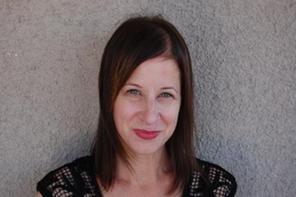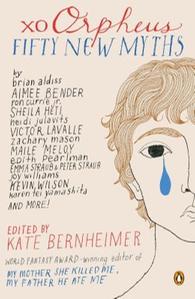
|
|
| photo: Brent Hendricks | |
Author and editor Kate Bernheimer has come up with a worthy successor to the World Fantasy Award-winning anthology My Mother She Killed Me, My Father He Ate Me: Forty New Fairy Tales. Her new book, xo Orpheus: Fifty New Myths (Penguin, $18 paperback), is a visceral, many-faceted collection of retold myths. Bernheimer shows a deft and cohesive touch in the stories she has chosen here; it is a beautiful, sometimes sad and harrowing collection. Her books include the novel trilogy The Complete Tales of Ketzia Gold, The Complete Tales of Merry Gold and The Complete Tales of Lucy Gold; the story collection Horse, Flower, Bird; and the children's book The Girl in the Castle Inside the Museum. Bernheimer is the founder and editor of the literary journal Fairy Tale Review and teaches in the MFA program at the University of Arizona.
What was your first encounter with myth? Do you remember a particular collection you loved or experience you had that resonated with you?
As a reader, I fell in love with mythology through the iconic D'Aulaires's Book of Greek Myths--the illustrations were so mysterious and grown up and scary. I pored over that volume. And at a young age, I discovered Edith Hamilton's Mythology, which I read cover to cover many times. I thought of it no differently than I thought of the Audubon field guide to birds of North America I also had by my bedside. The myths were that real to me--still are, really. I wouldn't have been surprised had I looked out my suburban window and seen a Pegasus among the American crows.
Myths and retold myths are good stories, but they can be so much more. In your foreword to xo Orpheus, you note that myths resonate so much with modern audiences because we've lost our sense of the sacred.
Certainly there are people and movements that try to maintain a sense of the sacred, but these are isolated exceptions to the presiding ontology of the 21st century that privileges the human species above all other forms of life, real and imagined. There can be little room for the sacred in the Age of the Anthropocene.
Do you think this loss of myth and story is one reason that young readers (and others) connect so passionately with tales of wizards and vampires?
Yes--most young readers have not fallen from wonder. As small and often powerless creatures, they easily accept fictional worlds where power lives in strange places, and where bad luck and good luck are not always logically or fairly distributed.

I invited all of the authors whose stories appear in the book to write a new work of prose based on what I referred to as "an old myth," and then I went on to establish that they could also work from a myth trope, a mythological character, a particular version of a particular myth or a favorite mythology book. All of the stories were written based on that invitation to myth. I wanted to see what "mythology" meant to as many writers as I could include in the book, as a way to see what "mythology" might comprise to contemporary authors--I wanted to see if there is something in the air about myth in this moment. I realized as the stories came in, often with apologies from the writer ("I'm sorry this is so dark"), that there is.
In your foreword, you also talk about how, earthy, real and visceral many of these tales are, that even though they are mythic they are very much of the moment. Did any stories surprise you more than others?
Thank you so much for noticing this. I felt the same way as I read the manuscripts. I was genuinely surprised by all of the stories--the down-to-earth quality of the writing was lyric and new. I felt a deep connection, emotionally, to the writers, most of whom I never have met--and to the old myths, which I was reading and researching in tandem. It was a profound experience, truly. I was in conversation with thousands of years of literature and 49 incredible current-day authors for around 11 months, around the clock--it affected my entire existence. My students heard about myths in the classroom; my nine-year-old daughter read them with me at bedtime.
What was it like working with a publishing house like Penguin?
My experience with Penguin has been fantastic--my editor, John Siciliano, has an intrinsic respect, a reader's real pleasure, in the innovative art form of fairy tale and myth. He's been immensely supportive of my mad desire to gather as many voices together as I can, which means collecting writers who are usually "relegated" to genre alongside those marginalized in the avant garde alongside those who might be household names (but shunned by "literary" readers) with decorated literary writers... in the same volumes. Fairy tales and myths cannot be boxed, cannot be contained. Everyone I've worked with at Penguin has been a delight.
What place does myth and fairy tales hold in your writing and teaching life?
It might be easier to talk about the place that myth and fairy tales do not hold in my writing and teaching life--because my answer would be silent! As a professor of creative writing, I find my students at all levels, and working in all styles; I find their art form illuminated and strengthened by the unusual and identifiable techniques of mythic literature, which I so love to teach. My writing comes directly out of my lifelong reader's infatuation with fairy tales and myths. From this love, too, I began Fairy Tale Review to provide a home for diverse literary works from around the world.
What's your next creative endeavor?
I'm putting the finishing touches on a story collection called How a Mother Weaned Her Girl from Fairy Tales that will be published next year by Coffee House Press, which has been super supportive of my strange fairy ways, and I am working hard on a grim novel called Happy Hour--an excerpt of it called "Floater" has just been published as a beautifully designed chapbook by Origami Zoo Press. --Donald Powell, freelance writer

